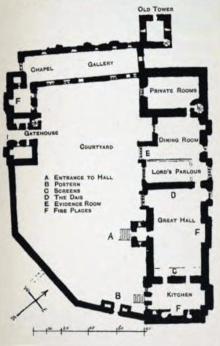Wharton Hall
| Wharton Hall | |
|---|---|
|
Wharton Hall | |
| Type | Fortified manor house |
| Location | Cumbria, England |
| Coordinates | 54°27′02″N 2°21′17″W / 54.4505°N 2.3547°WCoordinates: 54°27′02″N 2°21′17″W / 54.4505°N 2.3547°W |
| Architectural style(s) | medieval (limestone) |
Listed Building – Grade I | |
 Shown within Cumbria | |
Wharton Hall in Wharton, Cumbria, England, is a medieval fortified manor house.
History
At the heart of Wharton Hall is a 15th-century hall, built from local limestone by the local Wharton, possibly Richard Wharton.[1] During the Pilgrimage of Grace in 1536 the manor was besieged by the forces of Robert Aske and after 1544 Lord Wharton extended and fortified the manor, building a gatehouse, great hall, kitchen, and surrounding walls in a medieval style.[2] The result was a grand property, with the great hall being 68 feet long.[3]
The Wharton family preferred to use Healaugh Priory as their main residence after the 16th century, and the property fell into ruin. In 1785, Lord Lonsdale restored the building, adding more battlements.[4] It was restored again in the 20th century to its current condition.[5]
This site is a scheduled monument and grade I listed building. [6]
See also
- Castles in Great Britain and Ireland
- List of castles in England
- Grade I listed buildings in Cumbria
- Listed buildings in Wharton, Cumbria
References
- ↑ Emery, pp.255-256.
- ↑ Emery, p.256.
- ↑ Taylor, p.169.
- ↑ Emery, p.256.
- ↑ Emery, p.256.
- ↑ Historic England. "Wharton Hall (1137207)". National Heritage List for England. Retrieved 10 July 2015.
Bibliography
- Emery, Anthony. (1996) Greater Medieval Houses of England and Wales, 1300-1500: Northern England. Cambridge: Cambridge University Press. ISBN 978-0-521-49723-7.
- Taylor, M. W. (1892) Old Manorial Halls of Westmorland and Cumberland. Kendal: T. Wilson. OCLC 22355479.

